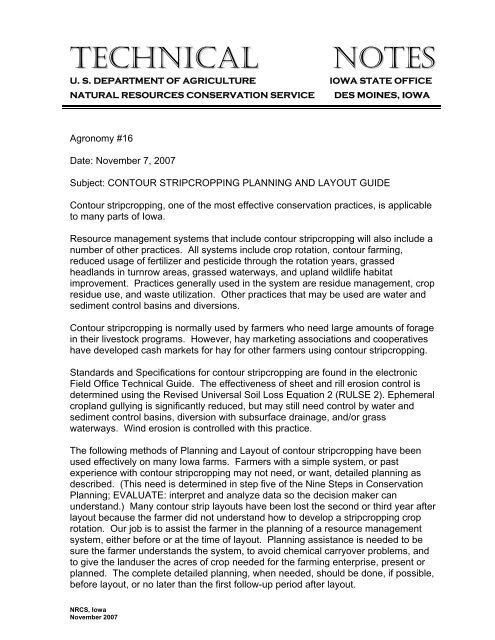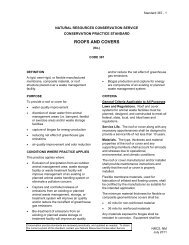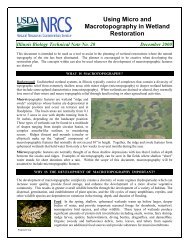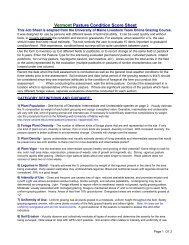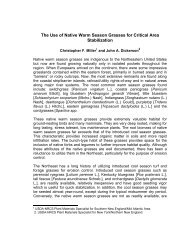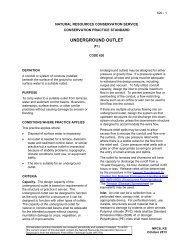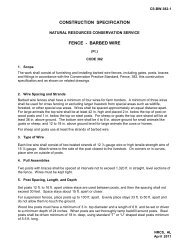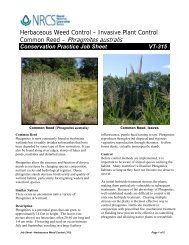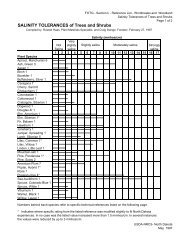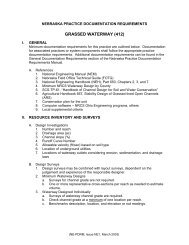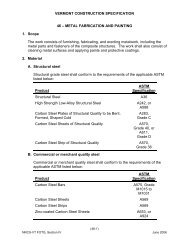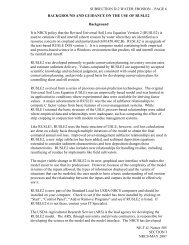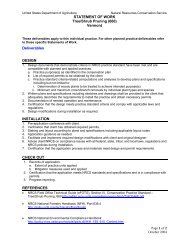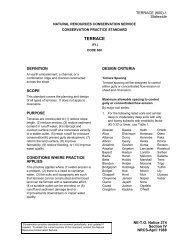technical notes - Field Office Technical Guide - US Department of ...
technical notes - Field Office Technical Guide - US Department of ...
technical notes - Field Office Technical Guide - US Department of ...
You also want an ePaper? Increase the reach of your titles
YUMPU automatically turns print PDFs into web optimized ePapers that Google loves.
TECHNICAL NOTES<br />
U. S. DEPARTMENT OF AGRICULTURE IOWA STATE OFFICE<br />
NATURAL RESOURCES CONSERVATION SERVICE DES MOINES, IOWA<br />
Agronomy #16<br />
Date: November 7, 2007<br />
Subject: CONTOUR STRIPCROPPING PLANNING AND LAYOUT GUIDE<br />
Contour stripcropping, one <strong>of</strong> the most effective conservation practices, is applicable<br />
to many parts <strong>of</strong> Iowa.<br />
Resource management systems that include contour stripcropping will also include a<br />
number <strong>of</strong> other practices. All systems include crop rotation, contour farming,<br />
reduced usage <strong>of</strong> fertilizer and pesticide through the rotation years, grassed<br />
headlands in turnrow areas, grassed waterways, and upland wildlife habitat<br />
improvement. Practices generally used in the system are residue management, crop<br />
residue use, and waste utilization. Other practices that may be used are water and<br />
sediment control basins and diversions.<br />
Contour stripcropping is normally used by farmers who need large amounts <strong>of</strong> forage<br />
in their livestock programs. However, hay marketing associations and cooperatives<br />
have developed cash markets for hay for other farmers using contour stripcropping.<br />
Standards and Specifications for contour stripcropping are found in the electronic<br />
<strong>Field</strong> <strong>Office</strong> <strong>Technical</strong> <strong>Guide</strong>. The effectiveness <strong>of</strong> sheet and rill erosion control is<br />
determined using the Revised Universal Soil Loss Equation 2 (RULSE 2). Ephemeral<br />
cropland gullying is significantly reduced, but may still need control by water and<br />
sediment control basins, diversion with subsurface drainage, and/or grass<br />
waterways. Wind erosion is controlled with this practice.<br />
The following methods <strong>of</strong> Planning and Layout <strong>of</strong> contour stripcropping have been<br />
used effectively on many Iowa farms. Farmers with a simple system, or past<br />
experience with contour stripcropping may not need, or want, detailed planning as<br />
described. (This need is determined in step five <strong>of</strong> the Nine Steps in Conservation<br />
Planning; EVALUATE: interpret and analyze data so the decision maker can<br />
understand.) Many contour strip layouts have been lost the second or third year after<br />
layout because the farmer did not understand how to develop a stripcropping crop<br />
rotation. Our job is to assist the farmer in the planning <strong>of</strong> a resource management<br />
system, either before or at the time <strong>of</strong> layout. Planning assistance is needed to be<br />
sure the farmer understands the system, to avoid chemical carryover problems, and<br />
to give the landuser the acres <strong>of</strong> crop needed for the farming enterprise, present or<br />
planned. The complete detailed planning, when needed, should be done, if possible,<br />
before layout, or no later than the first follow-up period after layout.<br />
NRCS, Iowa<br />
November 2007
2<br />
For those landusers who need and will use detailed planning, fields are usually<br />
combined to make larger units where possible. Fence removal may be an alternative<br />
to join adjacent fields to improve farmability. The field unit method simplifies the<br />
number <strong>of</strong> fields, and units are grouped in a manner to balance the acres per unit.<br />
Unit #I is made by removing the fence between old fields (1) and (3) for 62 acres<br />
total. With stripcropping, the loss <strong>of</strong> wildlife habitat along the removed fencerow is<br />
made up for by the new edge created along each strip boundary, and I grassed<br />
headlands. (This is true for all units.)<br />
Unit #II, 66 acres, is made by removing the fence between old fields (4) and (5) and<br />
making another divide on the ridge top to separate Units II and III. This ridge top<br />
divide helps balance acres in the units. Unit divisions are usually made on ridge<br />
tops, at drainage ways, and if no other way, on contour strip boundaries and farm<br />
lanes, etc.<br />
Unit #III uses the area east <strong>of</strong> the ridge top that ran through old field (5) <strong>of</strong> 18 acres<br />
plus combining old fields (6) and (7) for 50 acres, or a total <strong>of</strong> 68 acres in Unit III.<br />
This layout <strong>of</strong> three units gives you the number <strong>of</strong> units needed for a six year rotation<br />
<strong>of</strong> CCOMMM or CCCOMM. (CCCOMM is three years in row crop <strong>of</strong> corn, soybeans,<br />
etc., one year in small grain with new seeding, and two years <strong>of</strong> meadow forages for<br />
hay, silage, green chop, etc.)<br />
The number <strong>of</strong> units planned is determined by the crop rotation planned with the<br />
farmer based on his crop needs:<br />
NRCS, Iowa<br />
November 2007
3<br />
1. One unit is needed for COM or Cox rotations.<br />
(x = small grain with green manure)<br />
2. Two units for four year rotations <strong>of</strong> COMM or CCOM.<br />
3. Three units for six year rotations <strong>of</strong> CCOMM or CCCOMM.<br />
NRCS, Iowa<br />
November 2007<br />
Note: A direct seeding may replace the 0 year.<br />
Other Rotations:<br />
1. CCOMM rotation takes two approximately equal sized units for stripcropping<br />
and one field approximately one half the size <strong>of</strong> the units to be contour farmed<br />
with adequate conservation tillage and/or terraces as additional protection to<br />
compensate for reduced “P” values for contour strips versus contouring alone.<br />
2. CCCOMMM rotation takes three units plus one field one half the size <strong>of</strong> the<br />
stripped units to balance the acreages in the crop rotation.<br />
When preparing detailed planning, the unit method <strong>of</strong> planning simplifies the number<br />
<strong>of</strong> fields, and the arrangement <strong>of</strong> alternate strips within the unit are lettered in a series<br />
as (a) and (b) or (a), (b), and (c).<br />
EXAMPLE: Contour Stripcropping Lettering System<br />
*Unit III.<br />
Why show planned or applied strip locations?<br />
A. Some farmers will want to see approximately how strips will lay out before they<br />
make their decision in planning.
4<br />
B. Some farmers will need acres for farm programs; cash rent; custom rates;<br />
ordering and applying nutrients, pesticides, seeds; etc.<br />
C. Alternate strips are measured and lettered a and b in the example.<br />
D.<br />
a = 4.8 + 5.0 + 5.0 + 5.0 + 5.0 = 24.8 acres.<br />
b = 4.8 + 5.0 + 5.0 + 5.0 + 4.5 = 25.2 acres<br />
50.0 acres total in that part <strong>of</strong> Unit III mapped<br />
*Unit II.<br />
If planned or applied strip locations are not needed, estimate acres by assuming<br />
alternate (a) strips will be approximately one half the field, as will the (b) strips.<br />
a = 33 acres<br />
b = 33 acres<br />
66 acres total in Unit II<br />
If the farmer plans a COM rotation, strips would by lettered as (a), (b), and (c)<br />
repeating the process as you proceed from top to bottom. To estimate (a), (b), and<br />
(c) acres, divide total unit acres by three where not mapped and measured.<br />
Strip locations are determined on planning maps by use <strong>of</strong> Arc GIS, topography<br />
maps, and in the field with hand level checks. Also, note on the plan maps that<br />
“these are approximate strip locations – actual field layout may vary.”<br />
The effectiveness <strong>of</strong> contour stripcropping as an erosion control measure is<br />
dependent upon the arrangement <strong>of</strong> close growing crops with row crops in the crop<br />
rotation. The arrangement which gives the most effective erosion control is one in<br />
which the corn (row crop) strips area alternated with meadow strips, and the small<br />
grain strips are likewise alternated with the meadow strips. This requires crop<br />
rotations containing 50% or more meadow.<br />
EXAMPLE: In a CCOMMM rotation, when (a) strips the first three years in the<br />
rotation are CCO, the (b) strips are in MMM. When the (a) strips go to MMM in the<br />
second three years <strong>of</strong> this six year rotation, the (b) strips are in CCO.<br />
UNIT Year 1 Year 2 Year 3 Year 4 Year 5 Year 6 Year 7<br />
all (a)<br />
strips<br />
all (b)<br />
strips<br />
NRCS, Iowa<br />
November 2007<br />
C C O M M M C<br />
M M M C C O M
5<br />
With three nearly even sized units planned, the crops within the rotation years are<br />
staggered to balance out acres <strong>of</strong> crop:<br />
UNIT Year 1 Year 2 Year 3 Year 4 Year 5 Year 6 Year 7<br />
Unit I (a)<br />
strips<br />
Unit I (b)<br />
strips<br />
Unit II (a)<br />
strips<br />
Unit II (b)<br />
strips<br />
Unit III<br />
(a) strips<br />
Unit III<br />
(b) strips<br />
NRCS, Iowa<br />
November 2007<br />
C C O M M M C<br />
M M M C C O M<br />
C O M M M C C<br />
M M C C O M M<br />
O M M M C C O<br />
M C C O M M M<br />
NOTE: Each year has 1/3 rd row crop, 1/6 th small grain, and ½ meadow in a balanced<br />
CCOMMM rotation.<br />
Most <strong>of</strong> the time, the farmer using strips is either a dairy or beef cow producer who<br />
needs some rotation pasture (RP). Contour strip cropped fields would need too<br />
much fencing. An example rotation and conservation practice plan for strips and for<br />
rotation pasture might be:<br />
UNIT ACRES Year 1 Year 2 Year 3 Year 4 Year 5 Year 6 Year<br />
7<br />
Unit I 60<br />
acre (a)<br />
strips<br />
Unit I 60<br />
acre (b)<br />
strips<br />
Unit II<br />
60 acre<br />
(a) strips<br />
Unit II<br />
60 acre<br />
(b) strips<br />
<strong>Field</strong> (1)<br />
terrace<br />
30 acres<br />
<strong>Field</strong> (2)<br />
terrace<br />
30 acres<br />
30 C C O M M M C C<br />
30 M M M C C O M M<br />
30 C O M M M C C O<br />
30 M M C C O M M M<br />
30 O RP RP RP C C O RP<br />
30 RP C C O RP RP RP C<br />
Note: Each year has 1/3 rd (60 acres) in row crop, 1/6 th (30 acres) small grain, 1/3 rd<br />
(60 acres) meadow (hay, silage, green chop, etc.) and 1/6 th (30 acres) in rotation<br />
pasture.<br />
Year<br />
8
6<br />
The maximum grain production in a strip crop system is 50% in row crops. This is<br />
slightly less effective for erosion control, but it is a common rotation with today’s<br />
larger farms and increased hay yields.<br />
EXAMPLE: Based on the farm layout used to describe planning units and the<br />
lettering system.<br />
Conservation Cropping System:<br />
Units<br />
I.D.<br />
Total<br />
Acres<br />
NRCS, Iowa<br />
November 2007<br />
Strip<br />
I.D.<br />
Approximate<br />
Acres<br />
Yr.<br />
1<br />
I 62 a 31 O M C C C O M M C C<br />
b 31 C C O M M C C C O M<br />
II 66 a 33 C O M M C C C O M M<br />
b 33 O+H C C C O M M C C C<br />
III 68 a 34 M M M C C C O M M C<br />
b 34 C C C O M M C C C O<br />
Crop Summary (Acres)<br />
corn (C) 98 98 98 98 98 98 98 98 98 98<br />
oats (O) 56 33 31 34 33 31 34 33 31 34<br />
hay (M) 42 65 67 64 65 67 64 65 67 64<br />
Total 196<br />
Working into crop rotations can be complicated especially where chemical carryover<br />
is a problem. This usually means delaying the strip crop layout for a year to apply<br />
other weed control methods such as less persistent chemicals, cultivation, etc.<br />
When fields side by side are in different crops, or different age <strong>of</strong> meadow, are<br />
thrown together for form a workable unit, your alternatives are either delay strips a<br />
Yr<br />
2<br />
Yr.<br />
3<br />
Yr.<br />
4<br />
Yr.<br />
5<br />
Yr.<br />
6<br />
Yr.<br />
7<br />
Yr.<br />
8<br />
Yr.<br />
9<br />
Yr.<br />
10
7<br />
year to plant the unit to one crop or have multiple crops within the strips in the first<br />
year or two.<br />
EXAMPLE:<br />
Color coding step maps by years on complicated plans for new cooperators can help<br />
both the farmer and the Planner determine that “what is planned will work in the<br />
field.” As an example; color corn green, oats yellow, and meadow light brown. Use a<br />
color coded legend on the step maps.<br />
Even the veteran stripcropping farmer will benefit when you sit down with them in the<br />
field after layout. Draw up a rough layout <strong>of</strong> the strips in the field and discuss how to<br />
crop them this year and in future years. Give the farmer these rough <strong>notes</strong>.<br />
SUMMARY:<br />
As noted, there are many possibilities for rotation, many things that complicate ease<br />
<strong>of</strong> moving into the rotation, etc. that can confuse the person applying their first strips.<br />
Also, crop failure because <strong>of</strong> weather, seed, etc.; or a change in livestock programs<br />
etc. can mean revisions in the system. To minimize confusion, conservation planning<br />
is essential for contour stripcropping.<br />
CONTOUR STRIPCROP LAYOUT PROCEDURES:<br />
Contour strips should be laid out to effectively control erosion and at the same time<br />
permit farming with a minimum <strong>of</strong> inconvenience. The most convenient strips are<br />
even in width throughout their entire length. To secure maximum uniformity on<br />
irregular slopes, a cable (cam-line) is used and deviations from the true contour are<br />
made. Deviations should be within allowable limits as stipulated in the <strong>Technical</strong><br />
<strong>Guide</strong>. After the key lines are located, a cable is used for horizontal control, and a<br />
hand level for vertical control. Parallel strips are laid out to measured widths to<br />
accommodate row widths and row numbers to the equipment used to farm the strip.<br />
NRCS, Iowa<br />
November 2007
8<br />
Planter Size 4 – 38 6 – 30 12 - 30<br />
Strip Width (feet) 76 90 90<br />
101 105<br />
120 120<br />
127 135 150<br />
See table for suggested widths <strong>of</strong> strips for different planter sizes.<br />
EXAMPLE: If farmer uses a four row corn planter with 38” row widths: Four round<br />
trips will plant 32 rows which will return the planter, cultivator and harvester to the<br />
same end <strong>of</strong> the strip when finished as where started which is important to a lot <strong>of</strong><br />
farmers. With 32 rows 38” wide, the exact measured width is 101.3 ft. Use a 100 ft.<br />
strip width in layout in this case if the farmer is concerned with potential weed<br />
problems between strip boundaries. Other farmers may not have this concern, but<br />
would like a little extra width to avoid running down corn at harvest time because<br />
rows are too close on curves. Discuss this with the farmer before layout.<br />
Layout procedure is based on the assumption that one strip can be marked above a<br />
key contour and one or more below with corrections, if any, depending on the<br />
irregularity and length <strong>of</strong> the slopes. Therefore, the true key contour will always be<br />
located as the second line below the hill top. This key contour will seldom be the<br />
same continuous line around the field, because the top <strong>of</strong> the ridge is usually not<br />
level and a contour started as the second line below the high point in the field may<br />
soon become the first line below the ridge or eventually run out on top <strong>of</strong> ridge, if<br />
continued. Whenever the key contour is one strip width from the ridge top, it is<br />
stopped and a new key is continued one or two strip widths below. The key contour,<br />
then, is a number <strong>of</strong> segments at as many different levels (or strip widths apart) as is<br />
necessary to stay below the ridge top far enough to be able to cable <strong>of</strong>f one strip<br />
edge above the key segments.<br />
The following step by step procedure can best be understood by following the<br />
numbers on the attached sketches <strong>of</strong> strip layouts. On the sketches, all heavy lines<br />
indicate true contour lines located with a level. The lines with arrows (b, c) are key<br />
contours established before starting to cable <strong>of</strong>f parallel lines. Other heavy lines are<br />
corrections located with the hand level while strips were cabled <strong>of</strong>f. The first step in<br />
laying out contour strips is to locate a starting point. (No. 1 on sketches).<br />
Using a hand or other level, take a position one and a half strip widths below the<br />
highest point in the field. Position No. 1 is one and a half strip widths below the ridge<br />
high point. On nearly level horizontal ridge tops, shorten position No. 1 to one and a<br />
quarter strip widths below the ridge top. The principle, <strong>of</strong> course, is to leave a large<br />
enough top field to operate modern machinery easily but not so large as to allow<br />
excessive erosion.<br />
The following step by step procedure will demonstrate how Unit I can be staked and<br />
marked for stripcropping.<br />
NRCS, Iowa<br />
November 2007
NRCS, Iowa<br />
November 2007<br />
9<br />
1. From position No. 1, pace downhill one strip width to point No. 2. The average<br />
slope <strong>of</strong> the field should be used to determine strip width and the average will not<br />
usually occur at the edge <strong>of</strong> the field. This point will be the location for the start <strong>of</strong><br />
the first key contour line.<br />
2. From this point No. 2, stake key contour lines to nearest field boundary.<br />
3. Return to point No. 2, and stake key contour line along the slope (in directions <strong>of</strong><br />
arrows) until you reach the point where you are approximately one strip width<br />
below the ridge top.<br />
4. Pace downhill one more strip width to point No. 3 and continue the key line<br />
staking as before. Since there is room in the field for only one more strip below<br />
this line, you will continue around the nose <strong>of</strong> the hill as indicated by arrows until<br />
you reach a point about two strip widths from the top <strong>of</strong> the ridge.<br />
5. Pace one strip width uphill to point No. 4. This should put you about the same<br />
elevation, about one strip width from the ridge and about opposite the end <strong>of</strong> the<br />
key line started from position No. 2 over the ridge.<br />
6. From point No. 4, a key contour line is staked all the way to the boundary <strong>of</strong> the<br />
Unit I. This line should remain approximately two strip widths from the top <strong>of</strong> the<br />
field. If not, a new key line would be started.<br />
Sufficient key lines are now established so that all the remaining strip edges may be<br />
completed. With the aid <strong>of</strong> an assistant, a cable, and two different colored marking<br />
flags, the strips can be marked out. Alternate flag colors when marking strip<br />
boundaries. Also explain color coding and strip layout with the farmer before they<br />
start field work.<br />
The assistant walks along the established key contour segments while the technician<br />
walks and flags the new line using the cable between them. The technician, at this<br />
end <strong>of</strong> the cable, can determine if the new line is staying on the contour. If not,<br />
necessary corrections are made with a hand level. It is important that the cable be
10<br />
kept tight and always at right angles to the direction <strong>of</strong> travel <strong>of</strong> the person on the key<br />
line, at the measured length to assure farmable parallel strips.<br />
Final Staking:<br />
1. Start with assistant at point 5 and technician at point 6. Each one on the end <strong>of</strong><br />
the cable <strong>of</strong> the desired strip width.<br />
2. With a hand level, technician first stakes line to field boundary using a fence post,<br />
etc., as a sighting stake, and returns to point 6.<br />
3. From point 6, proceed to stake new line keeping cable tight and at right angles to<br />
assistant walking the key line below. This is strip edge (a) on the sketch.<br />
4. Stake line (a) until it approaches or points out on the ridge top (above point No.<br />
4).<br />
5. Assistant moves one strip width below point No.4 and technician starts at point 4<br />
and strip edge (b) is continued around ridge top to meet key contour staked from<br />
point No. 2.<br />
6. Move back to line (a) and finish staking through point No. 1. Since the assistant<br />
reaches the field boundary first, the last segment <strong>of</strong> line (a) is completed with a<br />
hand level as described in step No. 2.<br />
7. The assistant stays on line (b) and line (c) is staked back to point No. 3.<br />
8. From point 3, assistant goes to point 4 and technician finishes staking line (c) to<br />
the west edge <strong>of</strong> the unit.<br />
9. Line (d) is staked in similar manner except at the point where the line passes over<br />
the ridge <strong>of</strong> the hill. At this point the hand level is used to prevent the strip edge<br />
from deviating excessively from the true contour.<br />
Additional Examples:<br />
A similar layout procedure is followed in Units II, III, and IV shown with each unit<br />
having its own peculiarities.<br />
NRCS, Iowa<br />
November 2007
Unit II is an odd-shaped field with considerable variation in slope.<br />
Unit III has a ridge sloping about 4% or less with much steeper but rather uniform<br />
side slopes.<br />
NRCS, Iowa<br />
November 2007<br />
11<br />
Unit IV is a hill side field with high points on farm boundary fence one and a half strip<br />
widths above starting place (1).<br />
FACTORS THAT PROMPT LAYOUT VARIATIONS:<br />
A number <strong>of</strong> factors may prompt variations from the layout procedure outlined above:<br />
Some fields may have a secondary high point or dominant ridge below the highest<br />
point. If this secondary high point or ridge is a more dominating feature <strong>of</strong> the field<br />
that the highest point, then the starting point should be located from the dominating<br />
feature. This will assure the first key line being located properly for the greater part <strong>of</strong><br />
the field. Often this point, not being an important feature <strong>of</strong> the field, may be left in<br />
the top piece with the secondary highpoint or dominant ridge in which case no step<br />
up is made from the first key. Sometimes the minor highest point is so different from<br />
the main part <strong>of</strong> the field that it must be separated with a contour line that is not<br />
parallel to other lines. This results in two odd shaped top pieces rather than one,<br />
which may be necessary for adequate erosion control.<br />
Another factor to consider is that some slopes in the field are <strong>of</strong>ten steeper than other<br />
slopes. Where a noticeable difference in slope is observed, one or more and in some<br />
cases all <strong>of</strong> the strip widths on the steep side should be made narrower than on the<br />
flatter side.<br />
Another factor in making parallel lines is that in most cases any line laid parallel<br />
above a true contour line will tend to grade away from the waterways, resulting in<br />
implement marks leading run<strong>of</strong>f away from the waterways. If this occurs to any
12<br />
degree, erosion may be aggravated rather that reduced. For this reason, the<br />
procedure outlined allows only one line to be laid above the true contour on the<br />
smoother top <strong>of</strong> the field. On the other hand, laying parallel lines below a true<br />
contour usually increases the grade toward the waterways. This is desirable up to a<br />
point, depending on soil erodibility factors which govern the grading <strong>of</strong> strips. These<br />
limitations are found in the <strong>Field</strong> <strong>Office</strong> <strong>Technical</strong> <strong>Guide</strong>.<br />
OTHER CONSIDERATIONS:<br />
1. The strip must not be so wide as to cause more than the allowable soil loss<br />
across each strip. It is usually contemplated that the silt will drop out in the<br />
meadow strip below each strip <strong>of</strong> row crop.<br />
2. The person on the lower end <strong>of</strong> the cable must be alert and must be able to sense<br />
rise and fall. Stops should be made frequently and checked with a hand level. If<br />
the rise or fall is excessive, return to about where the line left the contour <strong>of</strong> the<br />
land and abandon the cable temporarily, run a level contour ahead until the<br />
contour line comes back to the normal strip width and again take up measurement<br />
with the cable.<br />
This shift <strong>of</strong> technique from even strip to contour line will cause a bulge or narrow<br />
place in the strip but it will result in a level line from which to start planting, and<br />
from which to measure the next strip below.<br />
3. One special case that sometimes gives trouble is a “saddle point”. This is a low<br />
ridge between two higher points in the same field. Ordinarily, the first contour is<br />
run from a point about 50 feet to one side <strong>of</strong> the low connecting ridge or saddle<br />
point.<br />
4. Plant row crops from the top <strong>of</strong> strip as it is usually the nearest on the contour.<br />
Stub or short rows drain on the meadow strip below. Cultivators, pickers, etc. can<br />
turn on the meadow strip also. The area above the top strip may be planted in the<br />
most convenient manner.<br />
5. A grassed turnstrip down the nose <strong>of</strong> a hill is desired by some farmers who find it<br />
easier to turn on, rather than try to farm the sharp corners that result when the<br />
nose <strong>of</strong> the slope is flatter than the side slopes <strong>of</strong> the hill leading to the nose. The<br />
width <strong>of</strong> this permanent grassed turnstrip should be planned for the forage<br />
harvesting equipment used by the farmer. This can be discussed with the farmer<br />
before layout.<br />
NRCS, Iowa<br />
November 2007
NRCS, Iowa<br />
November 2007<br />
13<br />
6. Grassed waterways should be left wide enough and extend far enough uphill to<br />
control erosion from run<strong>of</strong>f, as well as to serve as turnstrips as the contour strips<br />
change direction through drainage ways. Discuss with the farmer the correct<br />
method <strong>of</strong> planting to grassed waterways and turnstrips to avoid odd areas.<br />
7. Nose slope corrections require two additional strips to avoid double strip widths<br />
you would get with only one or three correction strips.<br />
EXAMPLE:<br />
TOPOG MAP: STRIPCROP LAYOUT CORRECTION<br />
Where the slope is steeper on STRIP MAP: One correction strip is<br />
one side <strong>of</strong> the nose slope that wrong. It always takes two. Butt the two<br />
the other side. correction strips into a strip that goes<br />
around the nose slope.<br />
8. On the exceptional field where slopes are nearly uniform on the entire field, the<br />
Key line can be located farther down the slope than on the average, more<br />
irregular slopes discussed earlier in this guide. By locating one-half way down the
14<br />
slope or more, one Key line will work. This will give you average parallel contour<br />
curves above and below this Key line. This method can also be blended into your<br />
overall field layout, using this method on the uniform slopes and the standard<br />
layout techniques on the more irregular slopes <strong>of</strong> the field.<br />
9. In the Planning information, it is recommended to avoid using contour strip<br />
boundaries as unit divides, if possible. This is most important where the crop<br />
rotation planned includes 50% row crops. With 50% row crop rotations, row crop<br />
strips match up against each other every four years a CCOM rotation and every<br />
6 th year with CCCOMM><br />
EXAMPLE: (CCOM rotation)<br />
Unit Strip One Two Three Four* Five Six Seven Eight* Nine<br />
I a C1 C2 O M C1 C2 O M C1 Contour strip<br />
b O M C1 C2 O M C1 C2 O boundary as<br />
II a C2 O M C1 C2 O M C1 C2 unit divide<br />
b M C1 C2 O M C1 C2 O M<br />
* Unit I b strip C2 matched up against Unit II a strip C1 (double wide C strip)<br />
10. Finally, establishing contouring or strips in units arranged for rectangular farming<br />
is <strong>of</strong>ten like trying to place round pegs in square holes. Special attention should<br />
be given to encouraging the farmer to relocate his unit boundaries parallel to the<br />
last strip, to eliminate as many irregular pieces, angling ends against fences, and<br />
short strips as possible. Attention to these and other details will result in the first<br />
class layout that will stay on the land and will long be the best possible<br />
advertisement <strong>of</strong> the product we have to sell.<br />
/s/David W. Beck<br />
Acting State Resource Conservationist<br />
NRCS, Iowa<br />
November 2007


